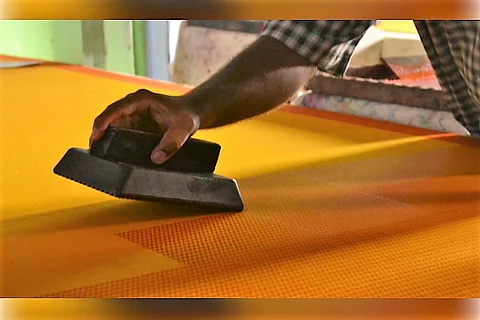

In this era of digital textile printing, have you ever wondered whether the engraved blocks of wood of yore still hold any relevance? If you thought ‘yes’, then you have reason to cheer.
According to the Global Export Import Market Intelligence data published by Infodrive India, the value of India’s exports of block-printed cotton fabric between March and September 2017 stood at USD 26,142. This reflects the rising popularity of this ancient art technique around the world. Some of the largest buyers of our exports include Japan and the UK.
Block printing, a technique whose usage is seen in a wide number of household items and apparel today such as sarees, curtains, shawls, shirts, pillow covers and so on, involves the transfer of a coloured design onto a fabric using blocks that could be made of wood or metal, or even vegetables like ladies finger, potato and capsicum.
In India, the centuries-old tradition is practised in various states across the country. Apart from Gujarat and Rajasthan, considered to be among the earliest practitioners, the craft has also found takers in Uttar Pradesh, Madhya Pradesh, West Bengal, Punjab and Andhra Pradesh. From birds and animals to flowers to gods and goddesses of popular mythological stories, each state has a wide variety of patterns that it uses on the fabric. To name a few, there is Gujarat’s Ajrakh, Rajasthan’s Calico and Syahi-Begar prints, and Andhra Pradesh’s Kalamkari.
In Chennai, although the craft is not indigenous to the city, the trend is catching on with a number of outlets selling block-printed wares. Chaani is one such brand that sells block-printed cotton sarees, with a blend of the contemporary and the traditional in its designs.
Inspiration and creating impact
“Soon after I quit my job in advertising, I wanted to do something that would have an impact on people’s lives. That’s when I went to this place called Tharamangalam near Salem. I specialise in block printing so I started working with weavers there and helped set up a block printing unit. We began with block-printed sarees. The fabric was woven, printed and sold from that place. Later, I expanded my work and began procuring fabric from various parts of the country,” says Vidyuth Sreenivasan, owner of Chaani, a brand promoted by Tasara Textiles and Design Studio.
When asked about the unusual name, Vidyuth explains, “When we started working with block printers, several of them were using cow dung in their kitchens. So we decided on the name ‘Chaani’, which means cow dung in Tamil, to represent the fuel that keeps the kitchen fires of block printers in rural India aflame.”
On what inspired him to take up this particular craft, Vidyuth says, “My mother started using the technique of block printing in 1984. My father passed away when I was around 3 or 4 years old. In order to the support the family and bring up two children, she started block printing on the terrace of the house and sold sarees under the name Varna. I thought I should continue her work. So that’s how block printing and Chaani came into the picture.”
What goes into creating the sarees
On the effort that goes into creating one saree, he says, “To make a saree, it takes anywhere between 4-5 hours or sometimes even a whole day, depending on the number of colours and blocks required. Sometimes, we can design a saree even with as little as 2 blocks. It all comes down to the design conceived on the block.”
Vidyuth, who is also a stage and film actor, procures fabric from across the country based on multiple factors, including longevity, colour absorption and availability. Then comes deciding the colour combination and coming up with the design, after which the saree is sent for printing.
“To assist me in printing, I have one craftsperson in Chennai, one in Tharamangalam and a family in Bakru, near Jaipur. At the end of the day, the material has to sell, so the design part is a trial and error process. Some colours will sell, some won’t. So I have to keep experimenting,” Vidyuth smiles.
Chaani plans to sell block-printed shirts from next month.
Talking about the business side of things, Vidyuth says, “How we present our product plays a big role. My clientele comprises women generally aged between 27 and 60. I’m trying to attract younger audiences. If a product is presented well and is relevant to the customer, then they will most likely buy it.”
On Chaani being a mainly online business, the entrepreneur says, “Thanks to the internet, e-commerce has helped small scale businesses like mine reach a wider audience. However, since it’s fabric, people still look for that ‘touch and feel’ factor and prefer offline mode of shopping. But once they buy a particular fabric and are comfortable with it, they are open to online shopping of the same product the second time.”
True to the belief that there’s no better way to learn a craft than by trying it yourself, Vidyuth provides an opportunity for patrons to gain hands-on experience in block printing through workshops.
He says, “I hold workshops because it is a fun activity and also to get people acquainted with the craft. I used to have demonstrations but found that a workshop was more immersive. Hopefully, these workshops will lead to greater appreciation of the effort that goes into the making of hand block-printed fabrics and encourage more people to try the craft.”